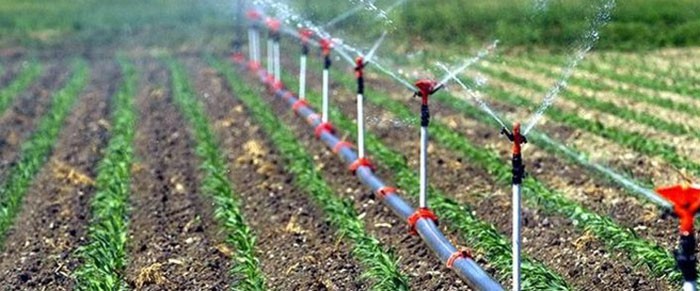There are various irrigation systems used in greenhouses, and an appropriate irrigation system should be selected according to the varieties and growth conditions of the greenhouse crops. Each irrigation system has its own advantages, disadvantages and performance characteristics. Choosing a suitable irrigation system is very important for greenhouse management.
Sprinkler irrigation system
1. The variable rail water wagon can generally be divided into two parts: the main engine (stainless steel main frame, three-position rotation, three kinds of water volume, anti-drip and leak-proof atomizing nozzle, wireless remote control, five-stage frequency conversion speed control electric control box) and two parts of the track .
①Running track: The main function is to realize the hanging and walking of the machine on the greenhouse frame, and the execution of sprinkler irrigation.
②Transfer track: The work track mechanism that transfers the machine from one greenhouse to another is called the transfer track.
③The track is mainly composed of booms, boom connectors, hooks and round pipes.
The main engine structure mainly includes geared motors, racks, spray booms and water inlet accessories, control systems, hoses, wires and hose blocks. The water with a certain pressure is connected to the host through a hose hung on the pulley, enters the spray rod through a filter, a pressure switch, and a solenoid valve, and finally passes through three quick-change nozzles for irrigation. The power cord is connected to the host along the water inlet hose.
2. the advantages of hanging sprinkler irrigation
①Sprinkler irrigation is the most even, so as to promote uniform growth of plants, ensure consistent quality, increase yield and reduce losses.
②Prevent the loss of water and fertilizer, save water for you, especially the expenditure of fertilizer. The water utilization rate of sprinkler irrigation water is 90%, while manual water application is only 50%.
③ Insecticides sprayed by sprinklers can avoid direct contact with people.
④The running track of the sprinkler irrigation machine can double as the slide track of the transport vehicle, one track can be used for multiple purposes, saving expenses.
⑤The running speed of the sprinkler can be adjusted infinitely variable frequency and variable speed, from 4 meters per minute to 15 meters per minute. This unique feature can provide different crops in your greenhouse with the precise amount of water and fertilizer they need.
⑥A variety of different programs can be set to achieve automatic intelligent control to meet the irrigation needs of different crops.
⑦ Manual operation or remote control operation.
Choose the appropriate irrigation method according to the change law of soil moisture in the greenhouse
According to the measurement of the soil water content in the solar greenhouse, it is found that the distribution of soil water content in the greenhouse is often uneven, with great differences in different regions. This is mainly caused by uneven soil temperature and internal circulation of water in the greenhouse environment. The greenhouse is a relatively closed system. In the cold winter, the soil temperature near the surrounding area is several degrees lower than the soil temperature in the middle of the greenhouse. The soil moisture evaporates slowly and the soil moisture is relatively high. Only a small part of the water evaporated by crops and soil is consumed through gaps and ventilation. Most of the water vapor forms water droplets in the room and then drips to the ground, forming an internal circulation in the greenhouse. The formation position and the drop position of the water drop are relatively fixed, resulting in uneven soil moisture.
It can be seen that drip irrigation will also cause uneven soil moisture to a certain extent. Where there is frequent excessive dripping, the roots of the crops will rot, plant weakness, disease, etc., and it may also alkalinize the local soil. In addition, the soil moisture varies greatly depending on the season. In winter, the temperature is low, the water consumption is low, and the moisturizing time is long after irrigation. Therefore, the irrigation should generally be sunny or cloudy just after the sunny day, and it is best to have sunny days for several consecutive days after irrigation. Irrigation in winter and early spring should be selected in the morning to restore ground temperature and dehumidify in time. In summer, the temperature is high, the sunlight is good, the crop transpiration and the ground evaporation are large, and the ventilation time is long, and the water loss is large, so irrigation should be increased.
To solve the problem of uneven soil moisture content, it is better to use micro-sprinkling (sometimes local) irrigation methods. But it should be noted that in the cold winter, in order to increase the soil temperature, a strict management system should be formulated for irrigation. After watering in winter, the ground temperature will generally drop by 2°C to 3°C. If it encounters continuous cloudy days after irrigation, the ground temperature will drop by 5°C to 8°C or more. At this time, storage water, deep well water, etc. should be used as much as possible for irrigation, and underground storage tanks should be set up where conditions permit, and cold water direct irrigation should be avoided.








